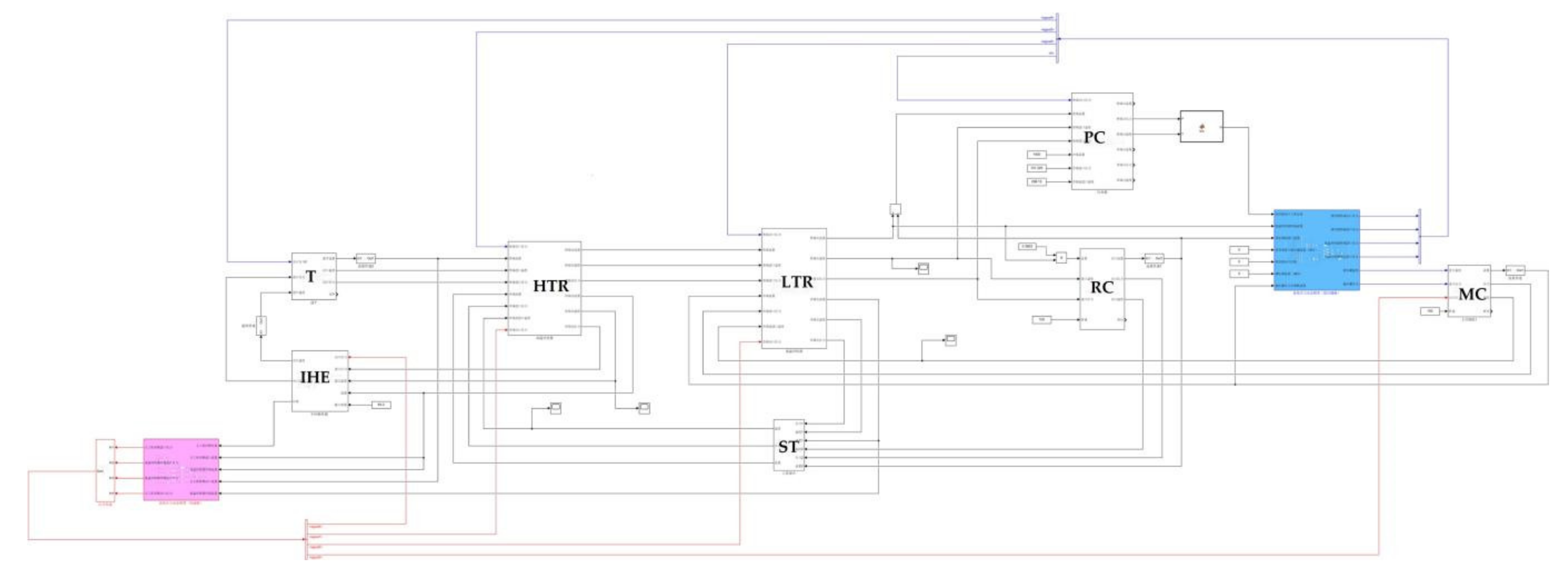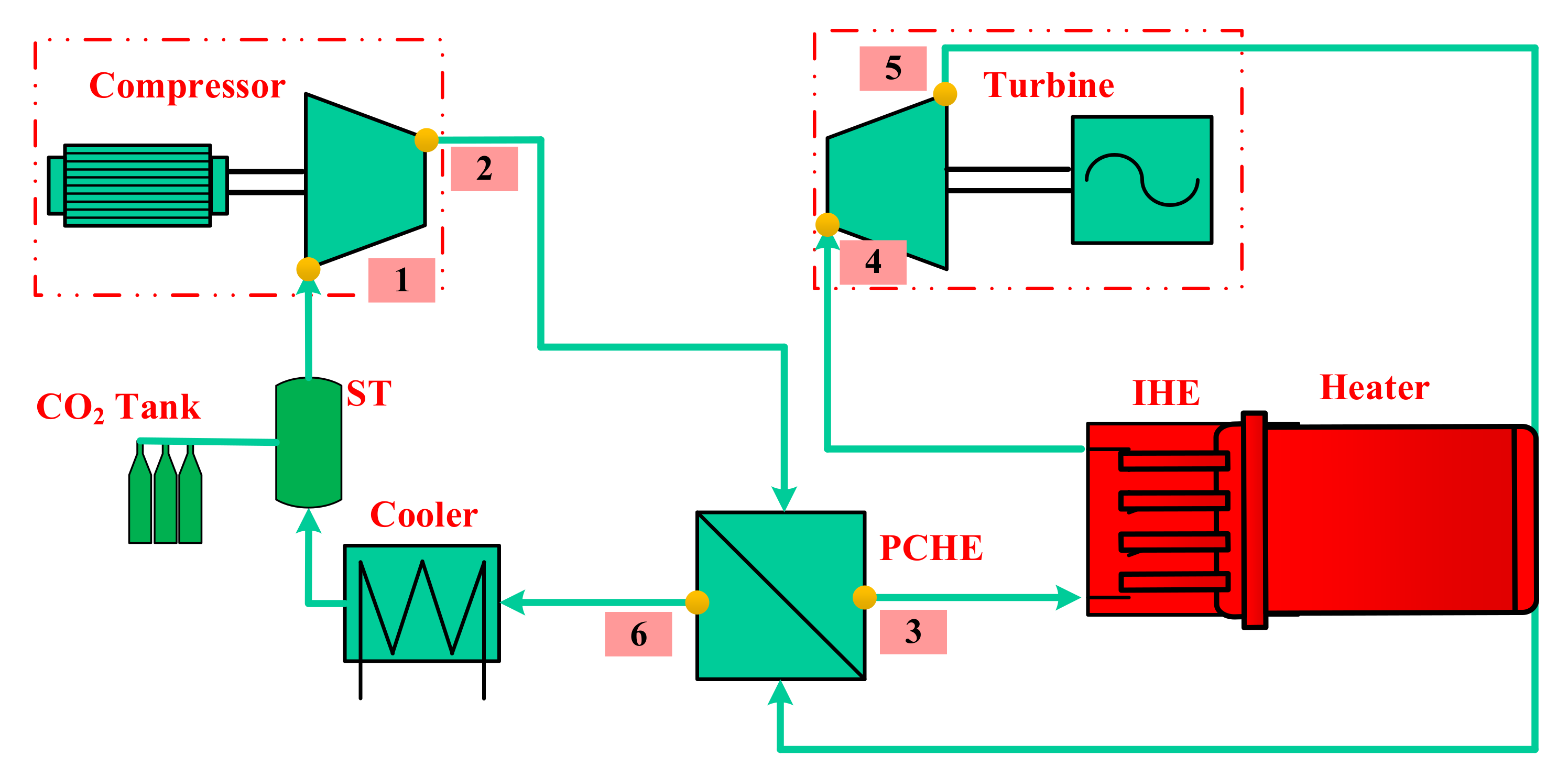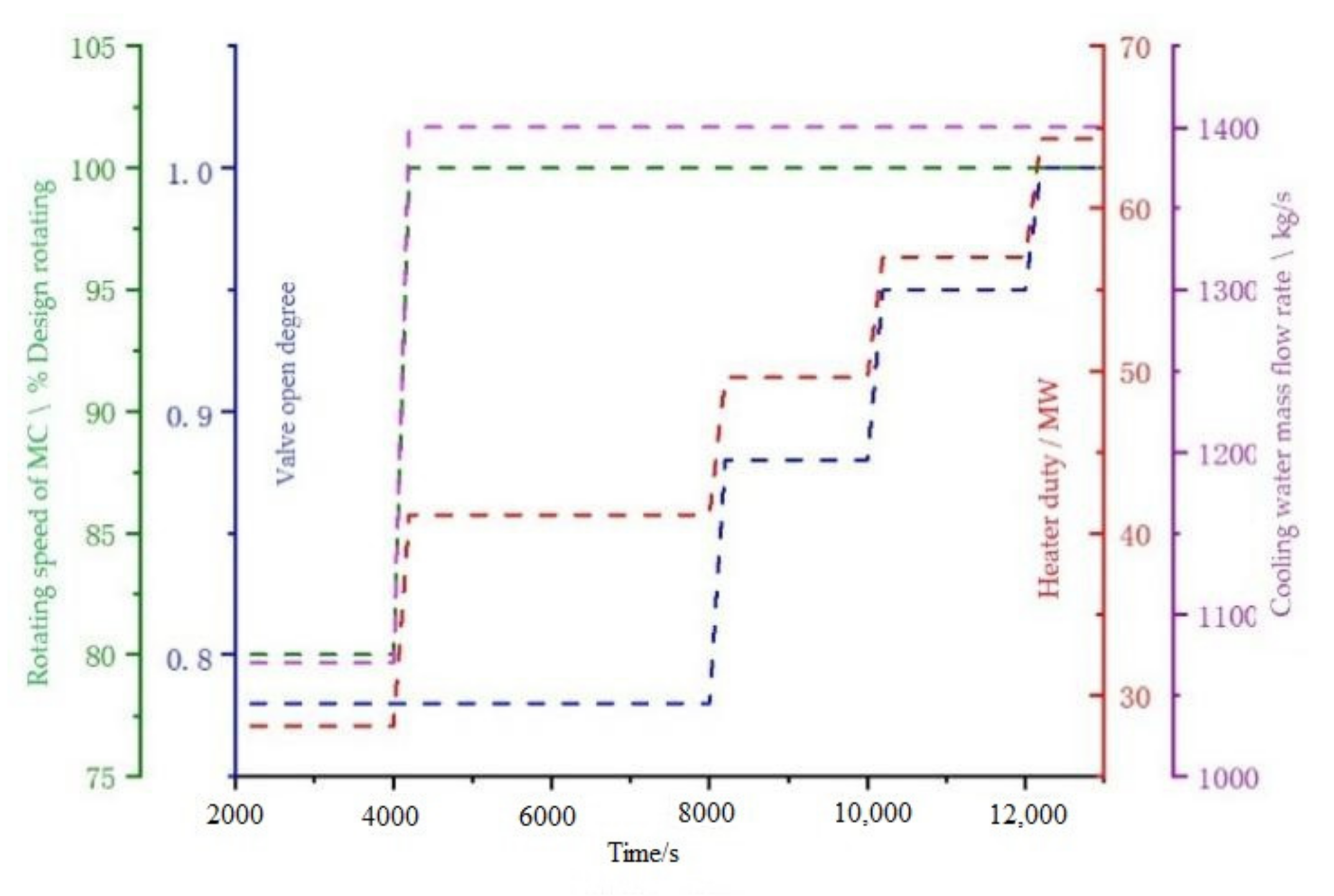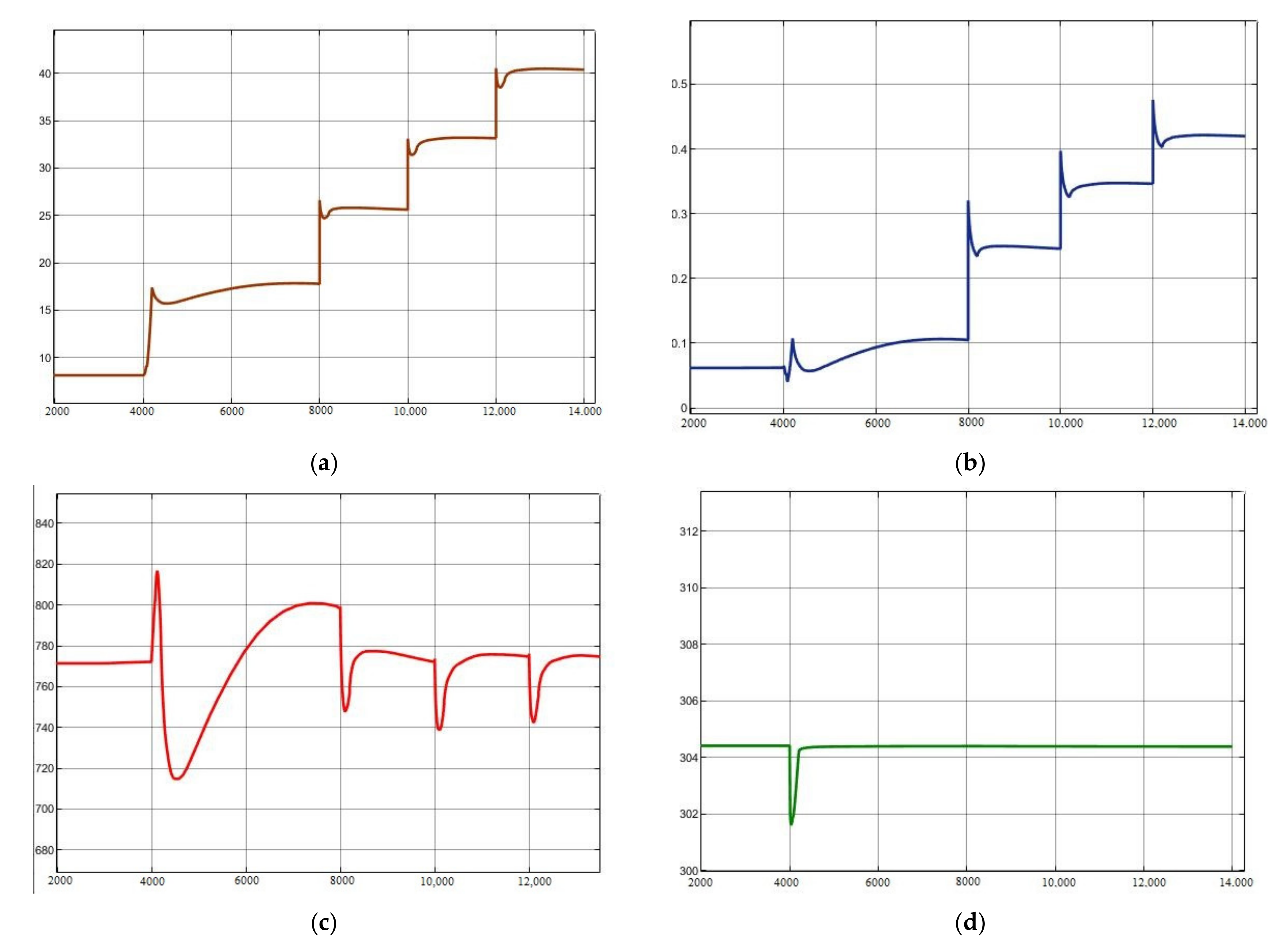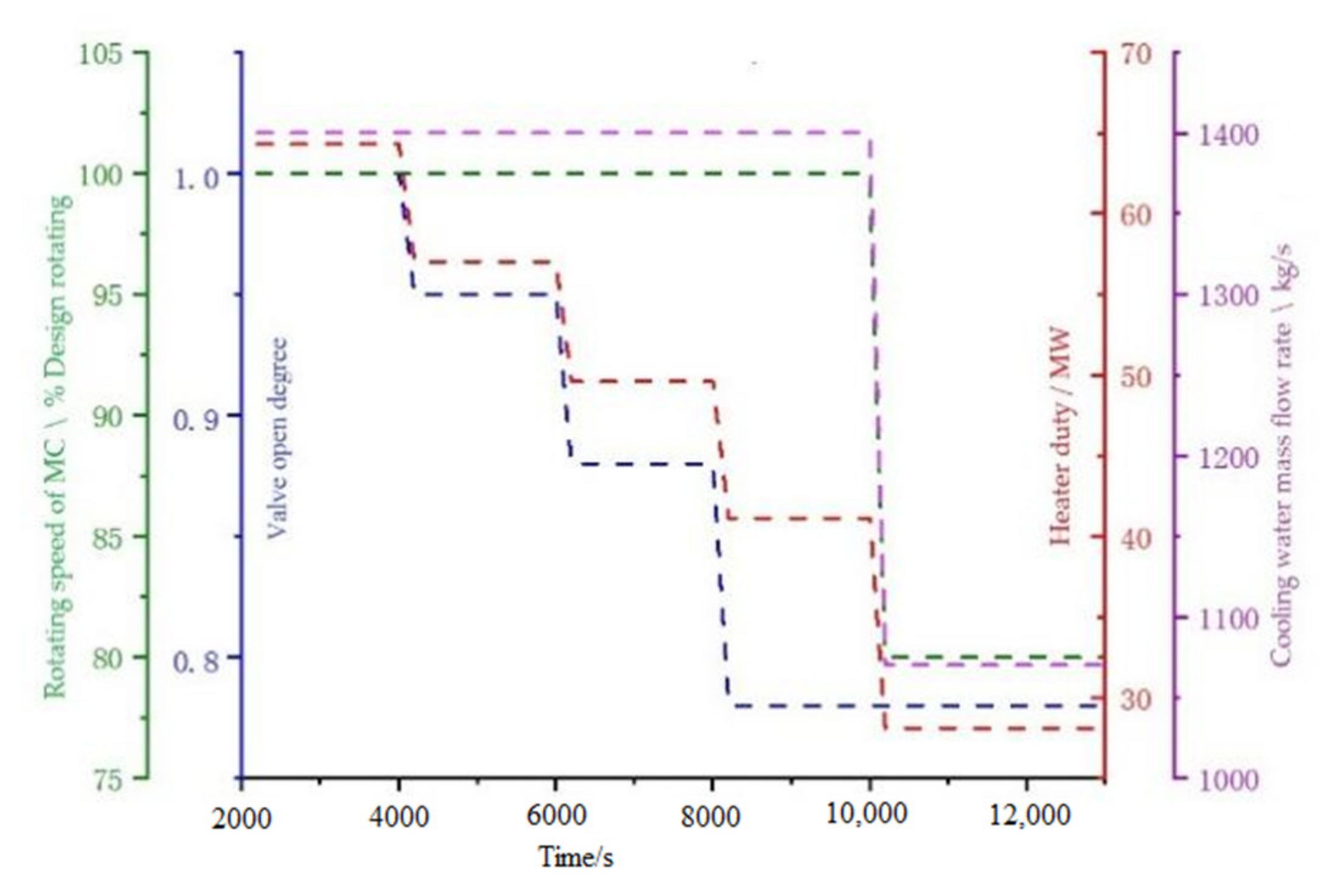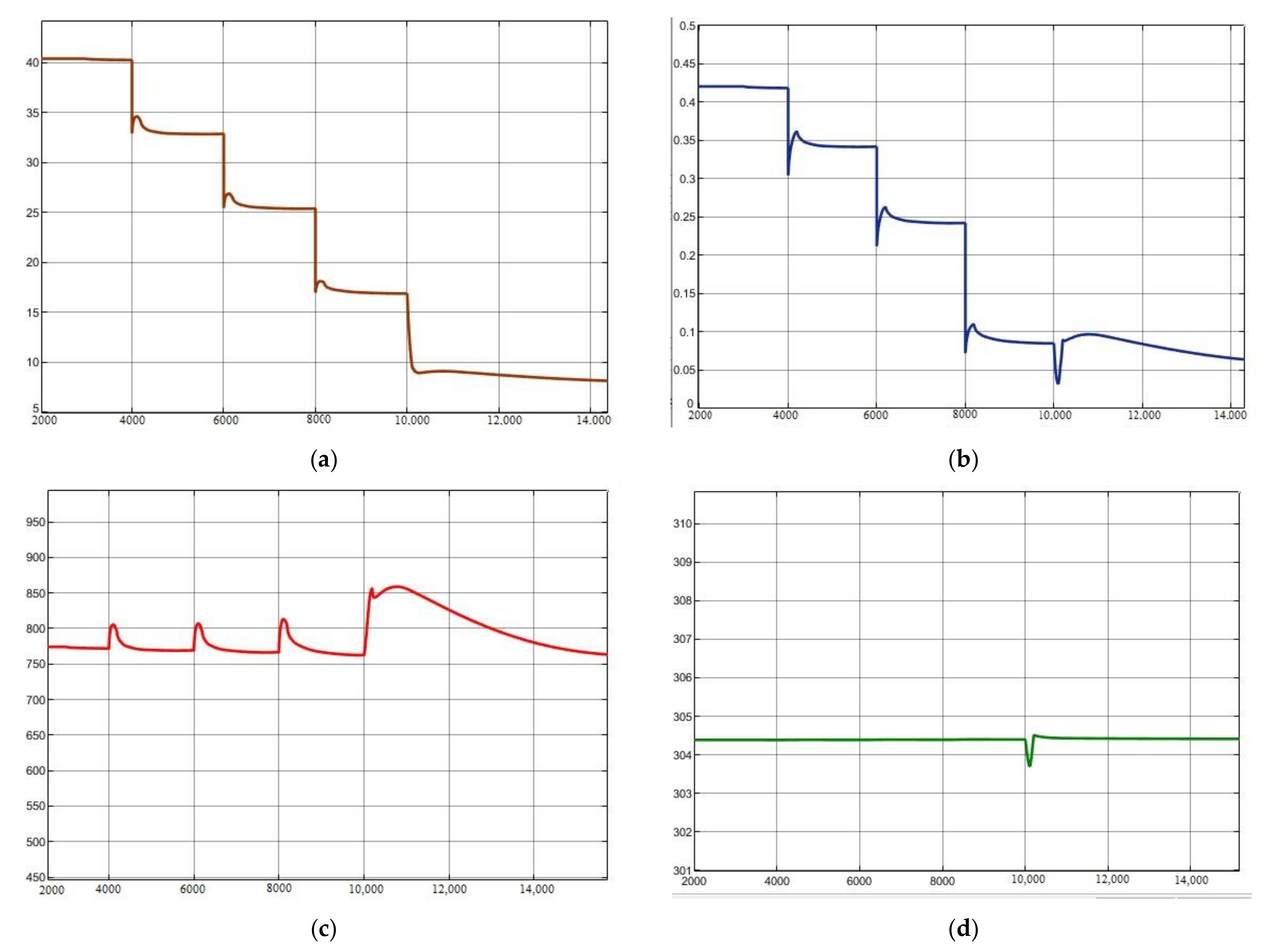1. Introduction
The supercritical carbon dioxide (SCO
2) cycle can be traced back to the 1960s, after which research on the cycle was temporarily shelved due to technical limitations [
1]. As the fourth-generation nuclear reactor developed rapidly in the 21st century, the operating temperature now reaches as high as 500–900 °C. Considering that the material reliability of the ultra-supercritical steam cycle cannot be guaranteed [
2], the SCO
2 Brayton cycle as an alternative cycle has attracted widespread attention from scholars. Additionally, comparative studies on the SCO
2 cycle, steam cycle, and helium cycle have also been carried out [
3,
4]. A large number of results show that the SCO
2 cycle is more suitable for higher temperature nuclear reactors due to the simple structure and high efficiency, and has the potential to reduce costs.
The SCO
2 cycle also has the advantages of a compact structure and good heat source matching performance, and can be widely used in nuclear energy [
5,
6,
7], waste heat recovery [
8,
9,
10], solar energy [
11,
12,
13], and thermal power [
14,
15,
16]. A lot of work has been done on the basic thermodynamic research of the SCO
2 cycle, configuration and parameter optimizations, system design in different application fields, and even economic analysis and optimization.
Sarkar [
17] performed second-law analysis of the SCO
2 cycle, and the results showed that the minimum operating temperature has a greater impact on the optimal pressure ratio and cycle efficiency than the maximum operating temperature, and the irreversibility of heat exchangers is significantly higher than that of turbomachinery. AHN et al. [
18] found that the recompression cycle showed the highest efficiency by comparing different cycle layouts. Moreover, the recompression cycle can effectively avoid the recuperator pinch point, which is more likely to occur in the simple recuperation cycle [
19]. Ma et al. [
20] analyzed the SCO
2 cycle with an intercooling system of the main compressor, and studied the influence of the pressure ratio and the pressure distribution of the two compression stages on the performance of the system. The results show that the coupled main compressor intercooling system can improve the cycle efficiency, save system cost, and improve cycle stability. Liu et al. [
14] studied the effects of the reheat stages on the cycle efficiency. Li et al. [
21] conceptually designed the power system of the SCO
2 cycle coupled with a small lead-cooled fast reactor, and analyzed the thermodynamic and economic performance. In addition, some scholars have conceptually designed the configurations of SCO
2 coal-fired power plants with different loads, and proposed a series of SCO
2 boiler and cycle-side temperature coupling methods to rationally utilize the flue gas heat [
15,
22,
23]. Zhu et al. [
24] used the weighted quality method to evaluate the cost of an SCO
2 boiler, and then evaluated the cost of SCO
2 coal-fired power generation, which shows the economic advantages of the SCO
2 cycle in the thermal power field. At the same time, a large quantity of related research has also been carried out in the fields of solar energy and waste heat recovery [
25,
26].
The above research has mainly focused on the steady state calculation. Since the SCO
2 cycle is used in the power generation system, attention needs to be focused on the performance of a variable load and flexibility. Thus, research on the performance and simulation of the SCO
2 cycle has also attracted attention from all over the world [
27]. Dyreby [
28] studied the method of SCO
2 Brayton cycles numerical modelling. Mois-seytsev and Sienicki [
29] simulated the performance characteristics of the 100 kW simple recuperated Brayton cycle configuration by developing The Plant Dynamics Code (PDC). Wu P. et al. [
30] and Deng T. et al. [
31] also developed the transient analysis code for the SCO
2 Brayton cycle.
As a supplement to the previous research, this paper studies the dynamic performance of the SCO2 recompression cycle of a 20 MW sodium-cooled reactor with Simulink software.
2. System Configuration and Modeling Descriptions
The power generation system described in this paper adopts the SCO
2 recompression cycle, and the configuration is shown in
Figure 1. The overall system includes a turbine (T), main compressor (MC), re-compressor (RC), high-temperature and low-temperature recuperators (HTRs and LTRs), intermediate heat exchanger (IHE), pre-cooler (PC), surge tank (ST), and heater.
As shown in
Figure 1, the high-temperature and high-pressure CO
2 from the IHE enters the turbine to do work and generates electricity. The exhausted CO
2 from turbine flows into the HTR and LTR and releases heat. The low-pressure fluid at the LTR outlet is then split into two streams: one stream is cooled in the PC and then compressed in the MC, and the other stream is directly compressed in the RC. Two streams converge at the high-pressure side outlet of LTR and are sent to the HTR and IHE for heating.
In order to meet the flexible control requirements, the MC, RC, and turbine adopt a split-axis layout. At the same time, the ST is arranged between the PC and the MC to facilitate the control of the MC inlet pressure and buffer the pressure change. The ST is connected with a CO2 storage tank, and the MC inlet pressure is maintained above the critical point by controlling the amount of CO2 in the ST.
This paper focuses on exploring the dynamic characteristics of the SCO2 recompression cycle, and the mathematical model of each component is developed to reflect the dominant characteristics of the cycle. The model of each component could be able to realize independent physical functions and be mathematically independent. At the same time, there are clear boundaries and data interfaces between the modules. The internal parameters of the models can be changed according to actual needs, and the impact of each parameter on the overall circulatory system can be analyzed. Based on the above requirements, this paper develops the dynamic model of the SCO2 system based on the Simulink platform, which is also convenient for system control strategy research.
5. System Dynamic Simulation of the Switching Working Condition
This section mainly studies the 20 MW-SCO
2 system dynamic characteristics in the process of switching between various operating conditions of 100%, 80%, 60%, 40%, and 20% load. The thermal parameters of each key node of the system under non-design operating conditions were estimated according to the performance curve of the equipment. The system mass flow rate was adjusted by changing the opening of the control valve in front of the turbine, so as to achieve the purpose of a variable load. Each working load had the corresponding compressor speed, heat duty, cooling water mass flow rate, and opening degree of the control valve, as shown in
Table 7.
In the simulation, the system initially operated stably under 20% operating conditions. When increasing the working load to the 40% load condition, the control valve opening degree was unchanged, and the compressor rotating speed, heat duty, and cooling water mass flow increased in a ramp manner. Then, the compressor and cooler maintained at the design condition and the control valve opening degree were increased continually to meet the load increase demand as shown in
Figure 9.
The system dynamic characteristics of the load-increasing process are shown in
Figure 10. As can be seen, this operating mode can switch operating conditions by adjusting the amount of turbine distribution, while the compressor operating environment remains unchanged. This method can avoid major changes in the compressor operating environment during variable operating conditions and is beneficial to the stable operation of the system. At the same time, this method has a fast rate of changing working conditions, which can meet the demand of a fast changing load. However, this method has certain limitations for a variable load: when the load demand is below 40%, the compressor speed and cooling water mass flow experience great changes. If switching working conditions at this time, the system parameters will fluctuate greatly, and the stability time will be long. Furthermore, the compressor power consumption has to be maintained at a relatively high level, so the cycle efficiency is very low when operating at a low load.
The load-decreasing process is the opposite of the load-increasing process as shown in
Figure 11, and the system dynamic characteristics are shown in
Figure 12. Assuming that the system initially operates stably under 100% operating conditions, the compressor and cooler operating conditions remained unchanged at first when reducing the load. The turbine power reduced with the decrease of the turbine gas flow rate and heat duty. When the load was below 40%, reducing the compressor rotating speed, and the cooling water mass flow rate at the same time caused fluctuation of the outlet temperature in the heat exchanger and displayed a longer stable time.
6. Conclusions
In this study, Simulink software was applied to develop a dynamic model of the 20 MW-SCO2 recompression cycle modularly. Corresponding component models were developed. A series of comparative calculations were carried out to verify the models. Additionally, the switching condition test of the 20 MW-SCO2 recompression cycle was conducted. The main conclusions of the study are as follows:
The models of a 20 MW-SCO2 recompression cycle were developed based on Simulink software, including heat exchanger models, compressor models, turbine models, and surge tank models.
The developed main component models were verified with the design values. The comparison results show that calculation errors are acceptable. The disturbance analysis results of the PCHE model were compared with PCHE in 1000 MW S-CO2 coal-fired power plant data to verify the dynamic simulation capacity of the model. Additionally, the prediction trends were consistent.
The SCO2 recompression power system was built with the developed models and the dynamic model ran stably and the maximum error was 0.56% compared to the design value.
The system dynamic characteristics were studied in the process of switching between various operating conditions of 100%, 80%, 60%, 40%, and 20% load. The analysis is instructive for the system operation and control.
Based on the analytical investigations, the results are very promising in that the developed model has the ability to evaluate the thermal-hydraulic characteristics of the SCO2 Brayton circulation system, but further experimental data are still needed to validate the code.






